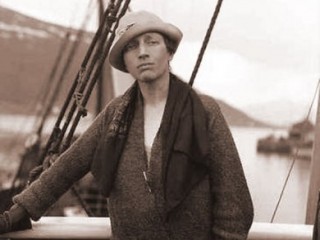
Louise Arner Boyd biography
Date of birth : 1887-09-16
Date of death : 1972-09-14
Birthplace : San Rafael, California, United States
Nationality : American
Category : Arhitecture and Engineering
Last modified : 2011-10-17
Credited as : arctic explorer, ,
Louise Arner Boyd financed and led several expeditions to the Arctic. She became an expert on the fiords and glaciers on the east coast of Greenland.
Louise Arner Boyd was born in San Rafael, California, north of San Francisco, on September 16, 1887. She came from a wealthy family, her grandfather having made a fortune in the California Gold Rush. Both of Boyd's brothers were sickly and died in childhood; her parents were also not well and traveled frequently for their health. Her mother died in 1919 and her father in 1920. They left the family fortune to their daughter, who succeeded her father as president of the Boyd Investment Company in San Francisco.
Boyd had traveled to Europe and Egypt and had worked as a nurse during the influenza epidemic of 1918. After her parents' death she returned to Europe with a friend and then went there a third time in 1924. She traveled on a Norwegian ship past North Cape, the northernmost point in Europe. As a result of that trip she developed an interest in exploring the Arctic.
Boyd made her first trip to the Arctic in the summer of 1926. She traveled to Franz Josef Land, a group of islands north of Siberia, to hunt for polar bears with friends. Boyd chartered the supply ship that had been used by the explorers Roald Amundsen and Lincoln Ellsworth. She returned with thousands of feet of film, 700 photographs, and a great desire to return.
Boyd returned to the Arctic in 1928 and chartered the same ship. She arrived just as a search was underway for Umberto Nobile, the Italian aviator whose airship had crashed on the polar ice. Nobile was rescued, but in the search operations Amundsen was lost and never found. Boyd offered her ship to those who were searching for Amundsen and spent four months with her crew looking for him. They were unsuccessful. However, as a result of her efforts, she was presented with a medal by the King of Norway.
Boyd set out again in 1931. This time she hired several scientists to make the trip a scientific venture. It also satisfied her longing for adventure. The expedition sailed up the east coast of Greenland, and later part of that coast was named Louise Boyd Land. This expedition began Boyd's association with the American Geographical Society, which sponsored her expedition in the summer of 1933 to Jan Mayen Island in the North Atlantic and to the fiord region of the east coast of Greenland. The expedition included several scientists, but the botanists became ill and Boyd took on the job of collecting plant specimens. She undertook expeditions to the same area in 1937 and 1938.
As a result of her increasing knowledge of these areas, Boyd was asked to represent several American learned societies at international conferences in Europe in 1934. The knowledge she had gained about the east coast of Greenland became very valuable after World War II broke out. The United States government requested that she not publish a book she was writing. Instead she was sent at the head of an expedition to investigate magnetic and radio phenomena in the Arctic in 1940. Her book, The Coast of Northeast Greenland, was published in 1948, after the war had ended. During the remainder of the war Boyd worked on secret assignments for the U.S. Department of the Army.
By the time the war was over, Boyd was almost 60 and did not take part in any further Arctic expeditions. She did, however, charter a private plane and fly across the North Pole in 1955, the first woman to do so. Boyd died in San Francisco on September 14, 1972, having spent most of her fortune to finance her Arctic explorations.
















